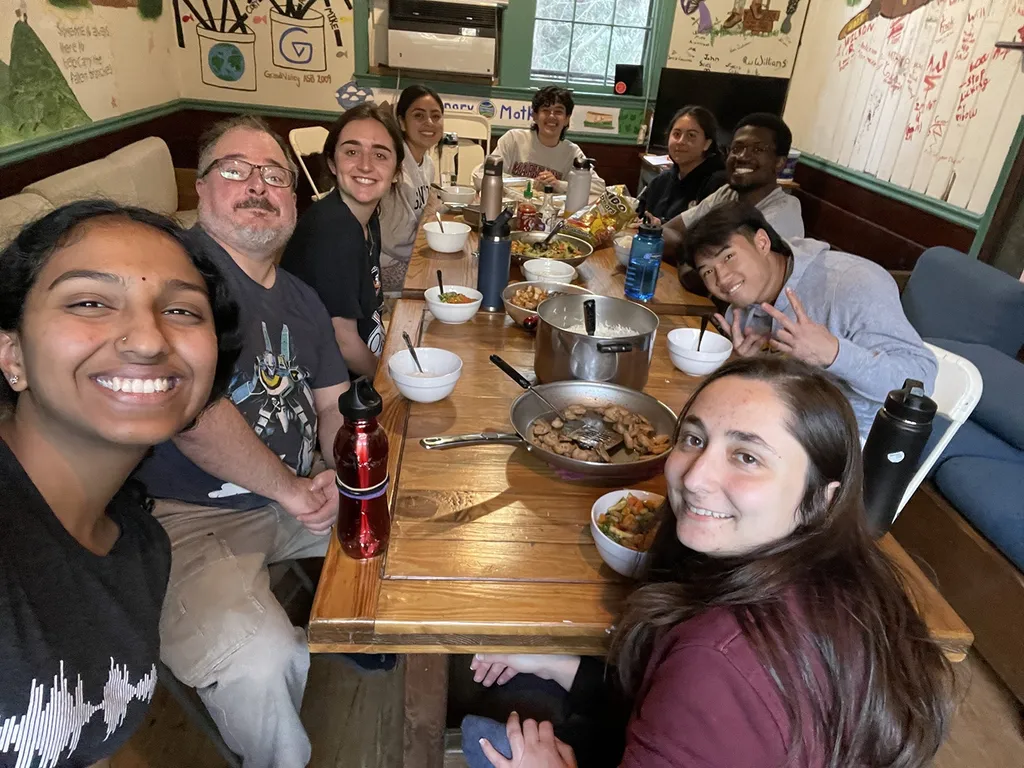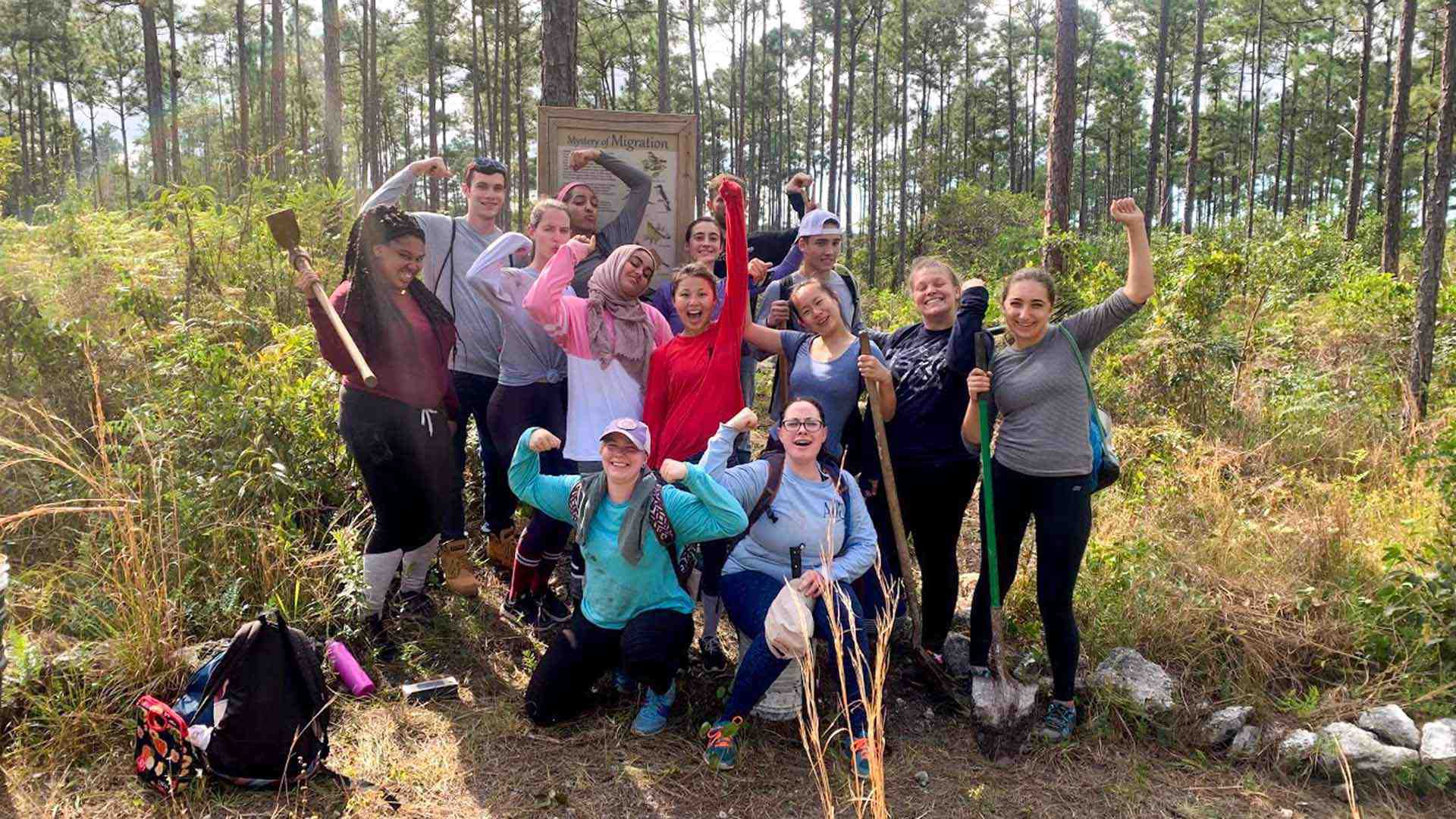- March 17, 2023
- By Karen Shih ’09
Think you have to head to a packed beach to make the most of your spring break? More than three dozen University of Maryland students are dispelling that myth as they pile into vans tomorrow to clear trail brush, restore oyster beds or repair homes as part of Alternative Breaks (AB).
Offered at the University of Maryland since 2004, the program pairs groups of students with nonprofit organizations that need additional hands. Terps traveled as far as the Caribbean and South Dakota prior to 2020, but this year’s six spring break trips are all within a five-hour drive, from a soup kitchen in West Virginia to a camp for children with autism in North Carolina.
Each trip is led by two student leaders who previously participated in AB as well as a staff advisor. Participants cover all their costs for the week, which can range from $125 (for local trips) to about $1,000 (for international trips), often through fundraisers.
AB Coordinator Naomi Cohen ’15, who works in the Office of Leadership and Community Service-Learning, and AB intern and experience leader (EL) Akshaya Balaji ’24 explain how the program is more than a weeklong commitment; the thorny logistics of housing, feeding and transporting students to sometimes-remote volunteer sites; and their favorite memories.
Naomi Cohen: Alternative Breaks are high-impact, short-term community service experiences open to any student at UMD. AB's values and philosophy directly counteract "voluntourism." We work closely with community partners to ensure that our direct service projects are actually needed by the community. The transformative experience we provide for students is further strengthened by issue education and reflections that they participate in, in addition to the direct service.
We go to different sites across the country, but the program took a big hit during COVID. We shifted to virtual dialogues about social issues, but now we’re starting to rebuild.
Our biggest recruitment tool is word of mouth; we used to have a pretty reliable pipeline when the program was bigger. We also have partnerships with living-learning communities that have service requirements, such as Global Communities and Integrated Life Sciences (ILS).
Akshaya Balaji: I’m in ILS, and I first joined the AB dialogue series online. When we came back in person last year, I became an EL for the trip to Hungry Mother State Park in Virginia.
NC: ELs usually apply right after we come back from our spring break trips, and we select them by the end of the school year. In the fall, they attend weekly leadership training sessions, where they learn to facilitate dialogues and manage logistics for the trips.
AB: For example, if the topic is environmental health and conservation, we’ll discuss how identity, such as socioeconomic status, racial background and location around the country, affects environmental health, health inequities and food insecurity.
ELs are also responsible for reaching out to community partners, discussing what we’ll do for the week, and putting together the itinerary. This year, I’m working with a longtime partner, the Chesapeake Bay Foundation. Since they know exactly what they want us to be doing, like oyster restoration and planting trees, it makes our lives easier.
NC: Late in the fall, we open up applications for participants and staff advisors. Advisors are awesome—the trips can’t happen without them. Our staff advisors come from all over campus and the roles are open to anyone who is a full time UMD staff or faculty member. Their main responsibilities are keeping track of the trips' finances and supporting the ELs.
Participants have to apply by February, and in early March, we have a kickoff event. Students have three pre-experience meetings before they depart on the first Saturday of spring break, returning the following Saturday.
AB: Groups get familiar with the community on Sunday, and the work starts Monday. At the state park, we did trail maintenance, restored streams and measured the health of the fish, and cleaned canoes. We also spent a lot of time splitting firewood—it was my first time using an axe! It’s a lot harder than it looks.

NC: On the trips, our philosophy is to live simply. We’re not taking students to the aquarium or out to dinner every night; there’s a pretty strict budget of about $9 per person, per day. They cook and eat together. Some community partners offer housing, and if they don’t, we often reach out to religious organizations in the area for free lodging.
AB: Last year, my co-EL and I put together a grocery list and went shopping at Costco to save money. We came in under budget and had so many leftovers! Everyone rotated cooking; we did a taco bar, pasta night, curry and a lot with tofu, since on an environmental trip, a lot of people are vegetarian.
We stayed in a cabin that had a bunch of different rooms with bunk beds. All the walls were covered with every AB group that had come, so we left our names too. It was very cute to see!
NC: I went to the Dominican Republic and Ecuador for my AB trips. We painted the entrance to this village a beautiful robin’s egg blue, put down foundation for houses and worked with an after-school program to put on a production of “Little Red Riding Hood.”
I gained so much confidence from becoming an EL—a lot of those soft skills like communication and time management. People were counting on me for important things, like making sure everyone got travel vaccinations and altitude pills since we were going to be in the mountains.
Leading the reflection dialogues every night, even if they were hard, was amazing. I hadn’t really gotten to know people like that before.
AB: This program has been life-changing. Everyone starts as strangers, but by day two, after being in a van together for six hours, you get really, really close. That’s the thing I love the most, bonding with fantastic people.
I don’t think I’m missing anything from the traditional spring break experience. I love being outdoors, so being at the state park, where we went on so many hikes, felt like a vacation to me.
This is part of a monthly series that looks behind the scenes at “what it takes” to keep the University of Maryland humming and create a vibrant campus experience. Got an idea for a future installment? Email kshih@umd.edu.
Topics
Campus & Community